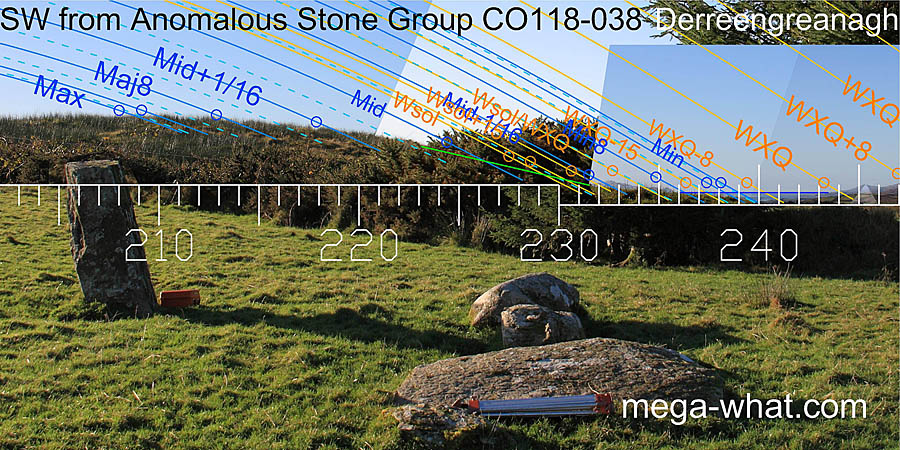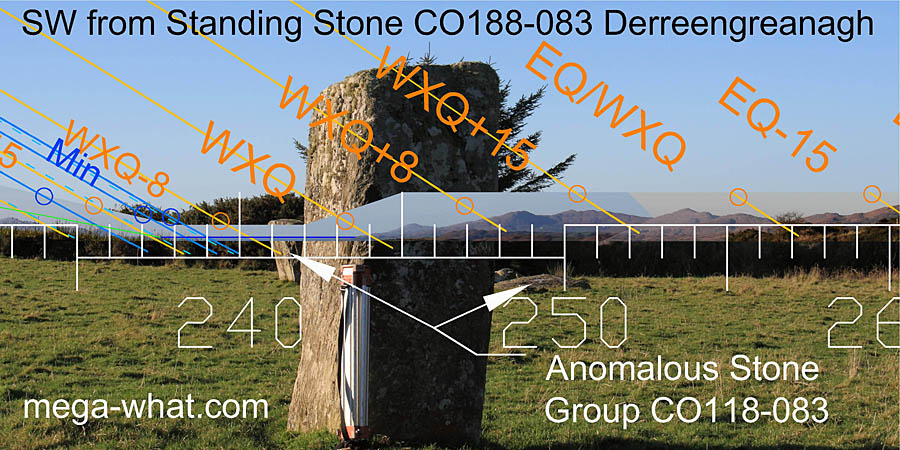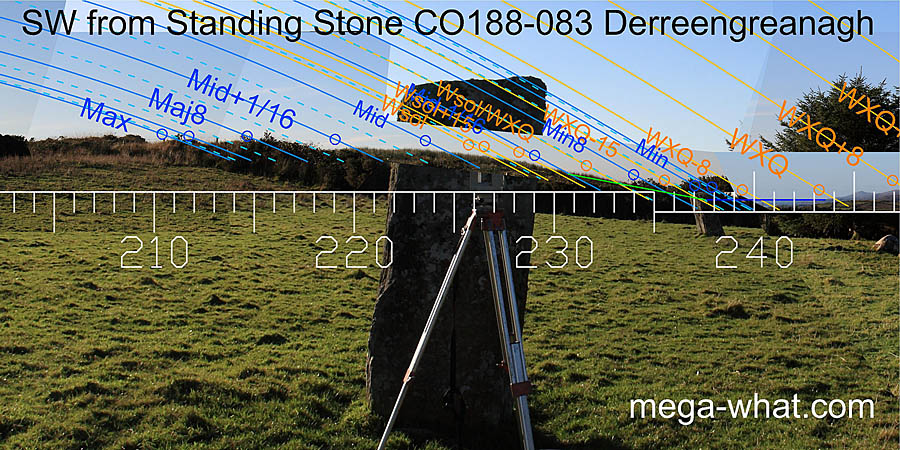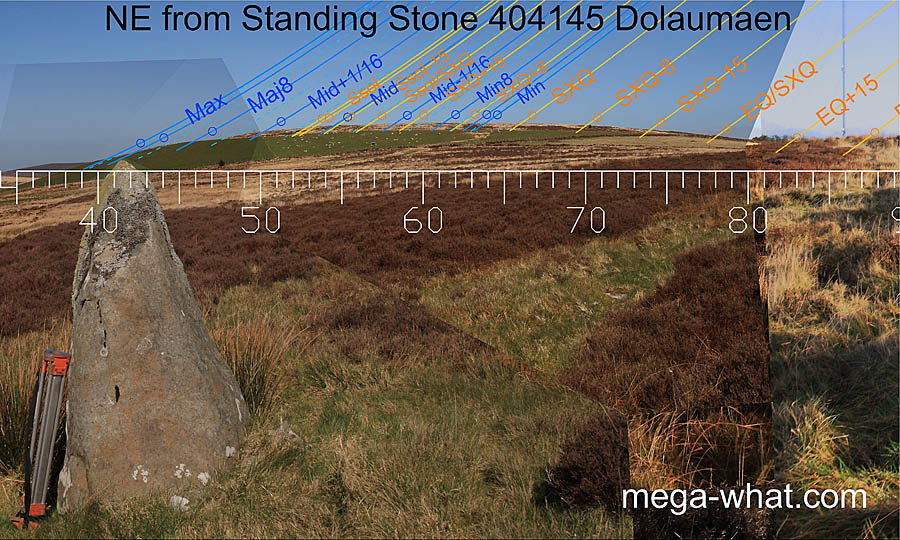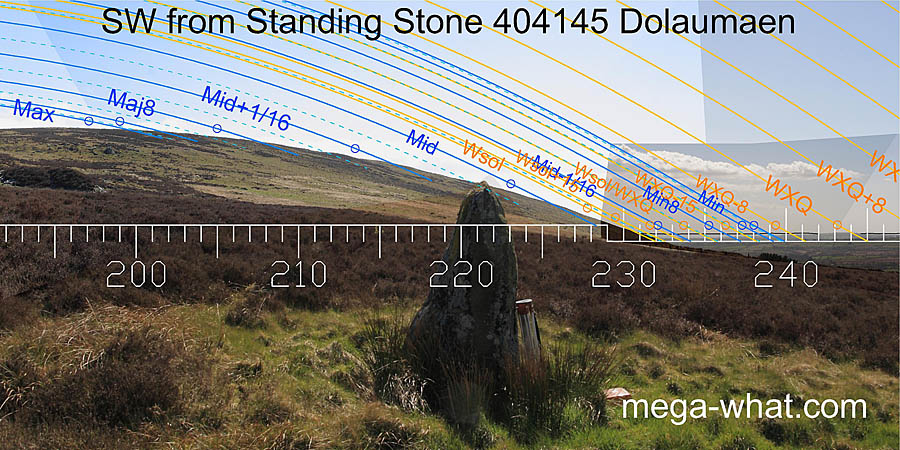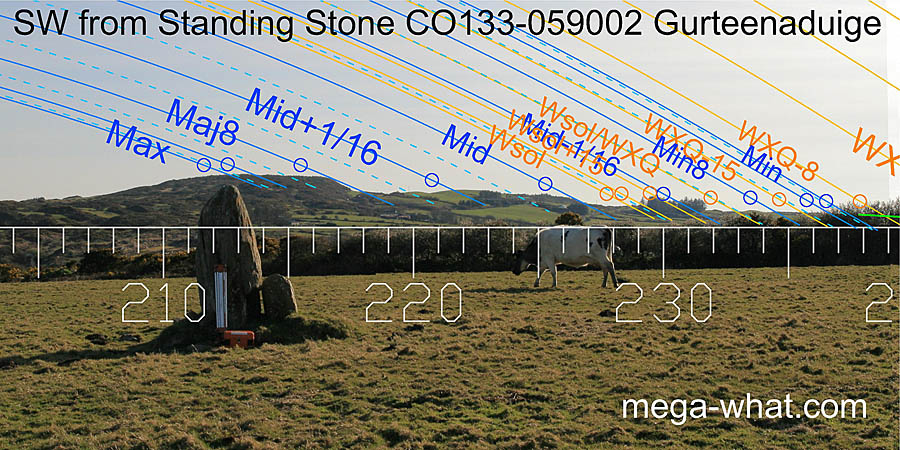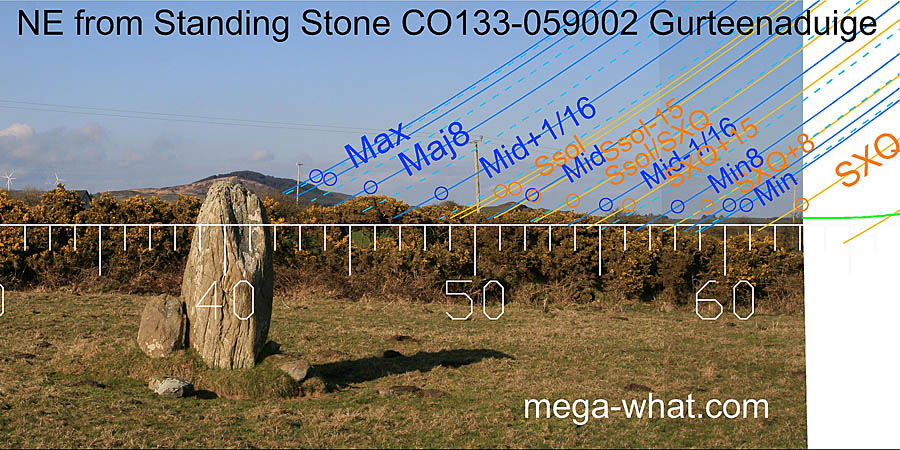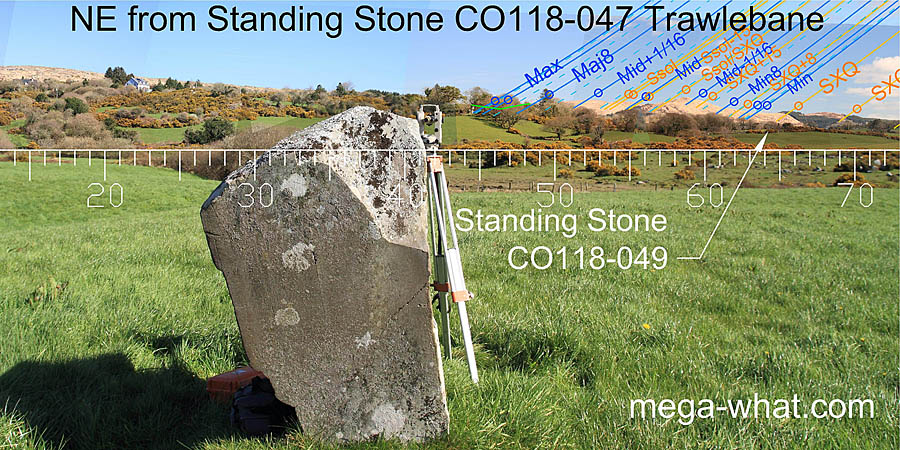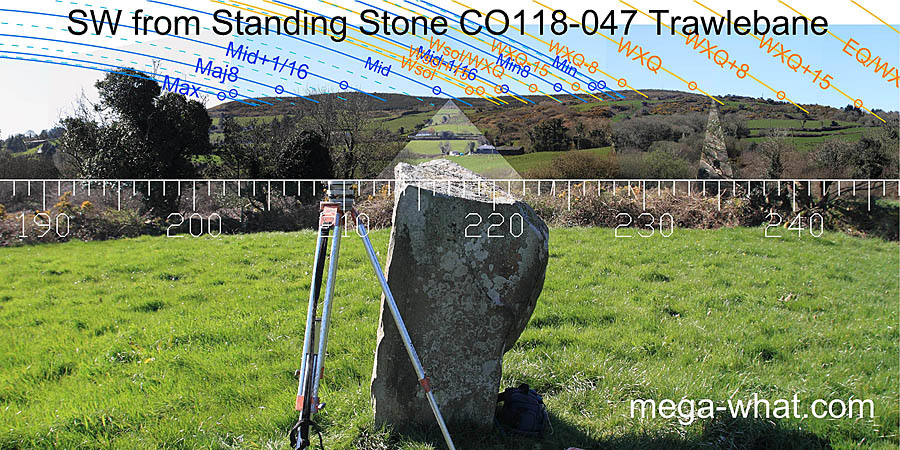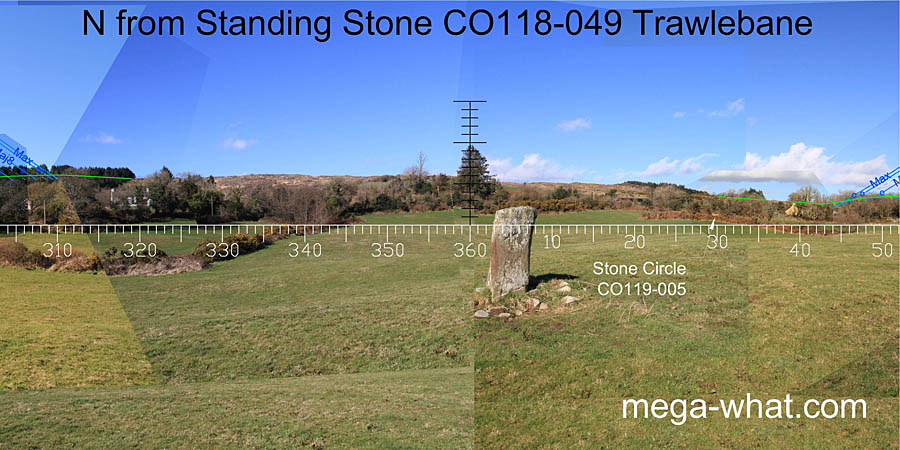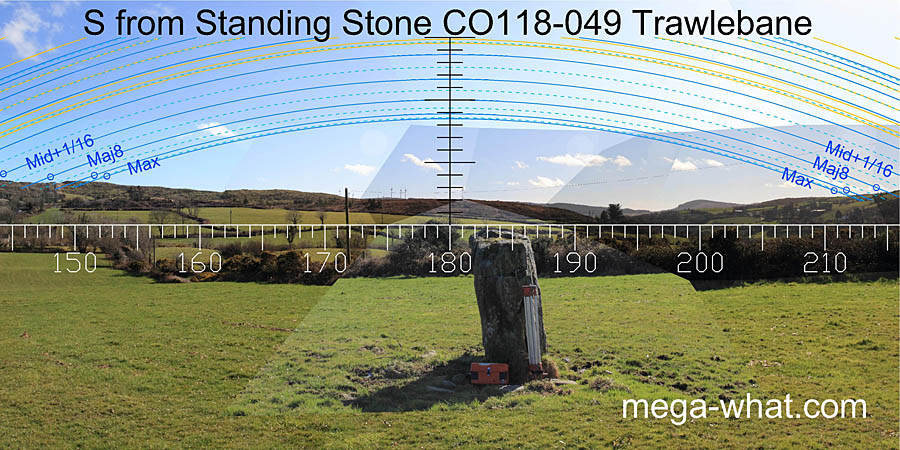Axial alignments of 20 surveyed Standing Stones.
Sorted by: Location Name | Alignment Class
Standing Stones are the simplest of all megalithic monuments. Thus they are the least studied.
Of these few examples, one is in West Wales. The others are all in Ireland and all except one are in West Cork.
- For classification purposes these surveyed horizons have been divided into a small number of zones.
This classification is an overall one that considers all axes to be potentially bi-directional.
- Extreme is where sun and moon never rise or set but excludes the north-south axis of celestial rotation.
- Lunar is where lunistices
Lunistices are the most northerly and southerly moons of the month. The lunar equivalent of solstices. More.
occur but sun rises or sets do not.
- Solar is where sun rises or sets occur but lunistices do not.
- Solar / Lunar is where a lunistice zone overlaps with the outer regions of the sun's annual travels.
Alternatively one direction may be purely solar while the other is somewhere within a lunistice range.
- Note that these terms may well have other uses elsewhere.
Axial Alignment Classes of surveyed standing stones
| Type | Number | %
|
|---|
| Solar | 6 | 30
|
| Solar / Lunar | 4 | 20
|
| Lunar | 5 | 25
|
| Extreme | 2 | 10
|
| North-South | 3 | 15
|
| All | 20 | 100
|
- This is a very small sample of the most common type of megalithic monument.
- Standing stones are the only surveyed monuments to have north-south axes, so far.
- One of those with an extreme axis is associated with a standing stone pair that also has an extreme axis, the other could possibly be a poorly aligned N/S.
- Apart from that, there is a fairly even split between solar and lunar.
Of this sample (excluding the two with extreme axes), five are uni-directional and eleven are bi-directional.
See for yourself:
- Orange Solar trajectories split the tropical year into 48 "Tweeks" (7.6 day mean) that are better regarded as quarter-months.
- Solid Blue Lunar lines split cyclical lunistice position variation into 16 periods of about 14 months each.
- Lunistices are the most northerly and southerly moons of the month [More].
- Also see Technical Notes on the Pictures

 Barnabah Standing Stone
Barnabah Standing Stone:
This stone is cup-marked and its long axis is roughly equinoctial.
Perhaps a week south of it to the east and a week north of it to the west.
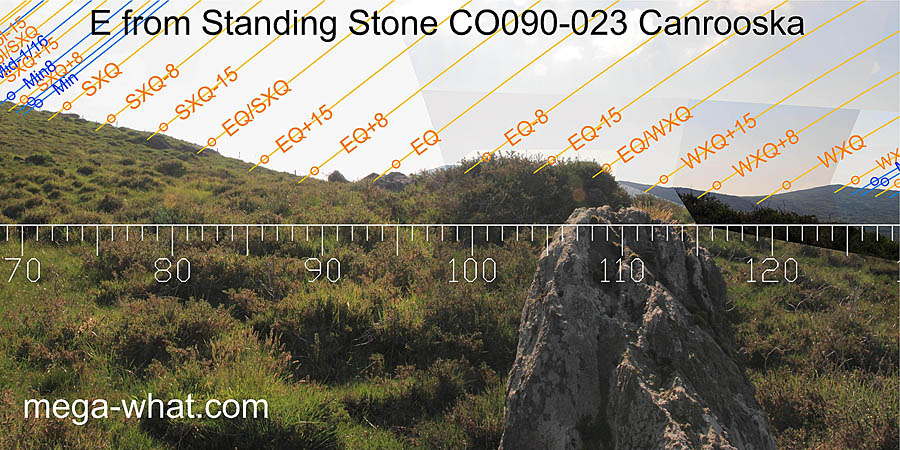
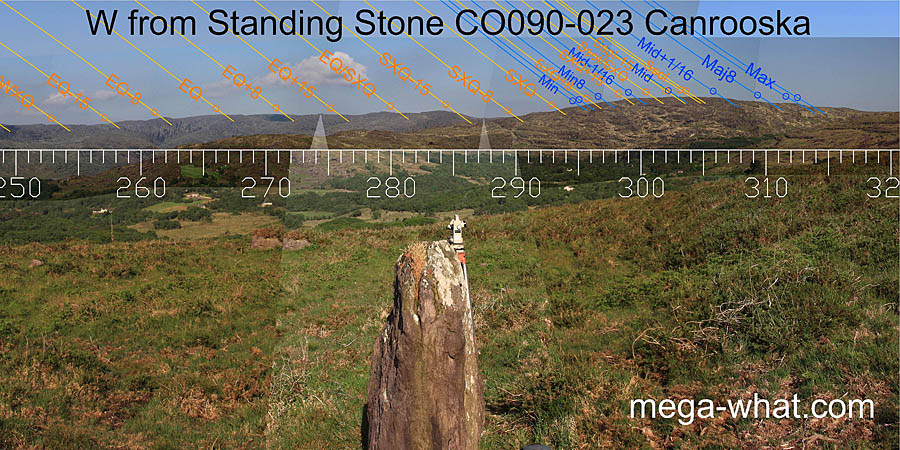 Canrooska Standing Stone
Canrooska Standing Stone:
The long axis of this stone is towards the equinox / cross-quarter midpoint in both directions.
Because it is on a slope, it is easy to make it cut the eastern horizon.
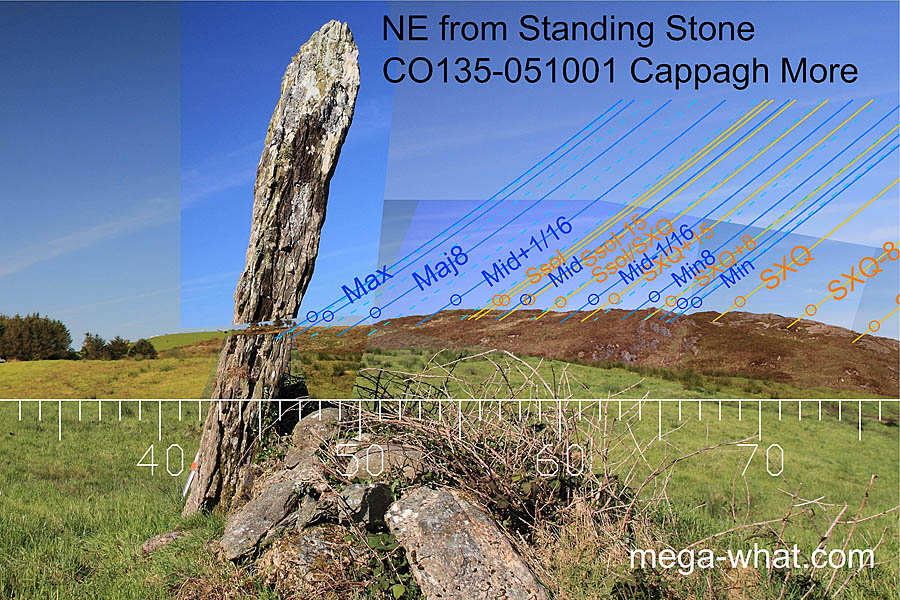
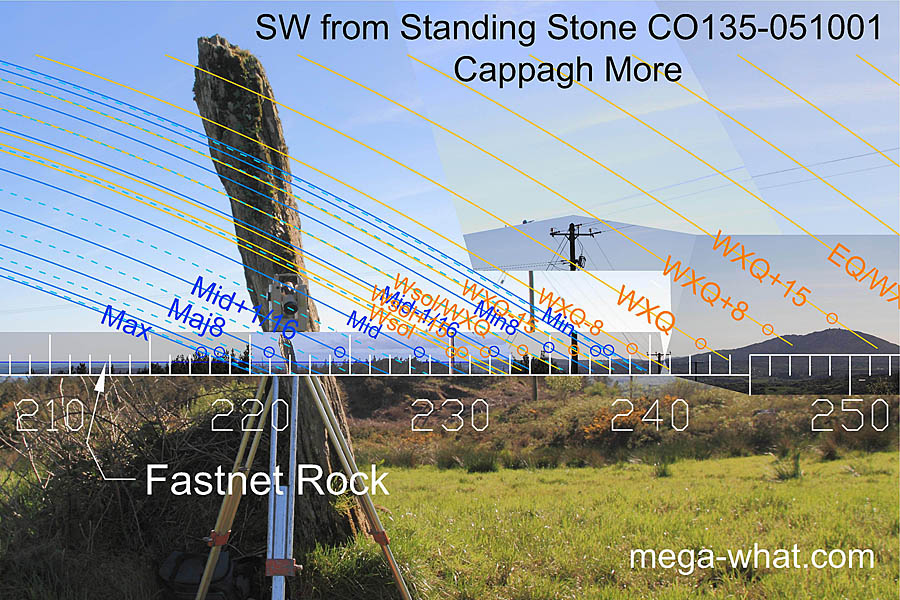 Cappagh More Standing Stone
Cappagh More Standing Stone:
One of two stones (the other fallen) 30m apart, with a combined NW/SE axis.
This one is slightly beyond major standstill to the north-east, maybe
the sixteenth on the major side of mid-cycle to the south-west.
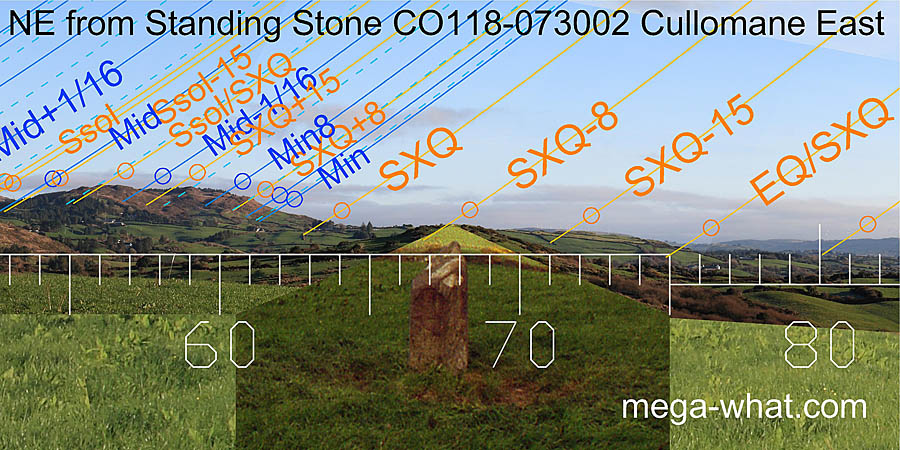
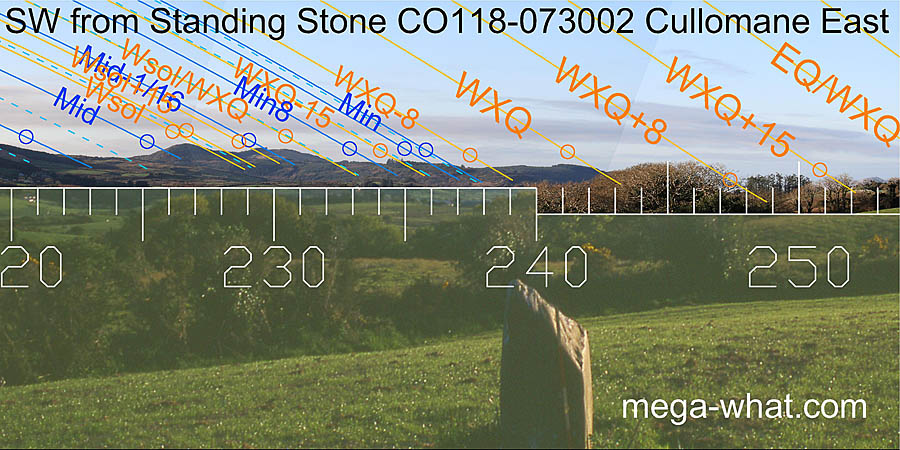 Cullomane Standing Stone
Cullomane Standing Stone
This stone (now fallen) is an outlyer of a stone circle but may have been there first as there was a series of standing stones in this area, most now gone.
Its axis was about a quarter-month south of both summer and winter cross-quarters.

 Derryarkane Standing Stone
Derryarkane Standing Stone:
This outlier of a five stone circle has an axis about 10° clockwise of east / west.
To the east it points a week or so south of the equinox (before the spring one).
To the west it seems to indicate the equinox / summer cross-quarter midpoint but the sightline is obscured.

 Farnoge Standing Stone
Farnoge Standing Stone:
The long axis of this stone was more or less north-south.
The north view shows it before it fell, the south view is after unsupervised re-erection.

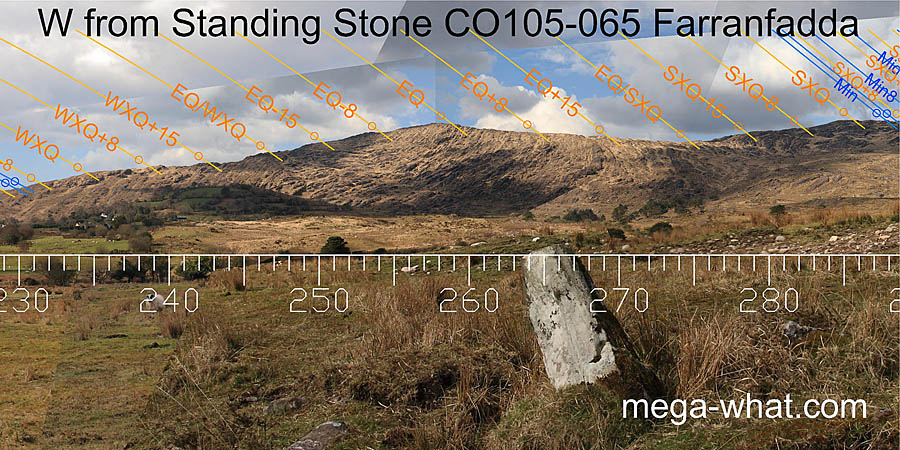 Farranfadda Standing Stone
Farranfadda Standing Stone:
This stone is leaning badly but may have been intended to indicate the equinox / cross-quarter midpoints in both directions.
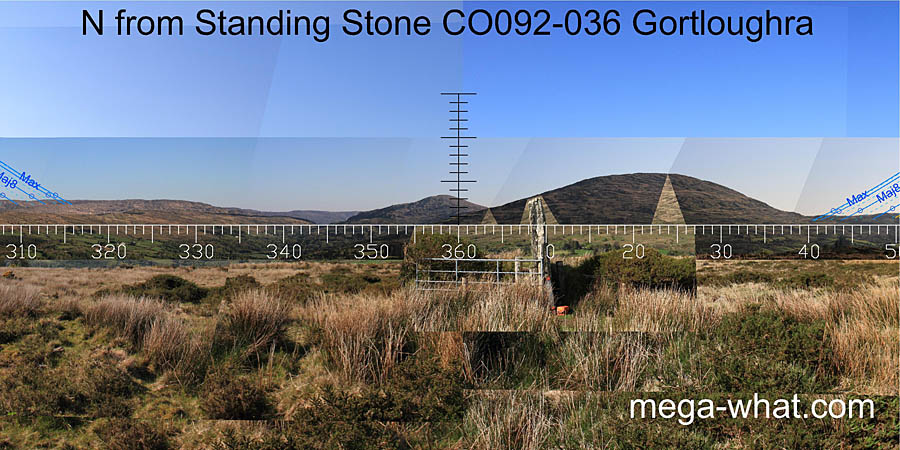
 Gortloughra Standing Stone
Gortloughra Standing Stone:
The long axis is 10° or so clockwise of north-south, which
roughly bisects the space between south and the south-western major standstill.

 Maughanaclea Five Stone Circle & Standing Stone
Maughanaclea Five Stone Circle & Standing Stone:
This standing stone marks major standstill to the north-east and
the circle indicates the area of summer solstice sun rises
[Pic].
To the south-west the standing stone marks the solstice and the circle indicates the winter cross-quarters.
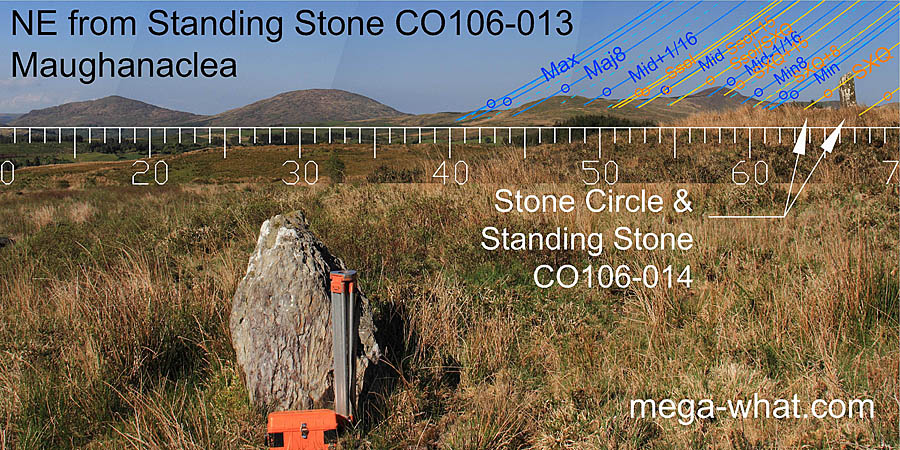
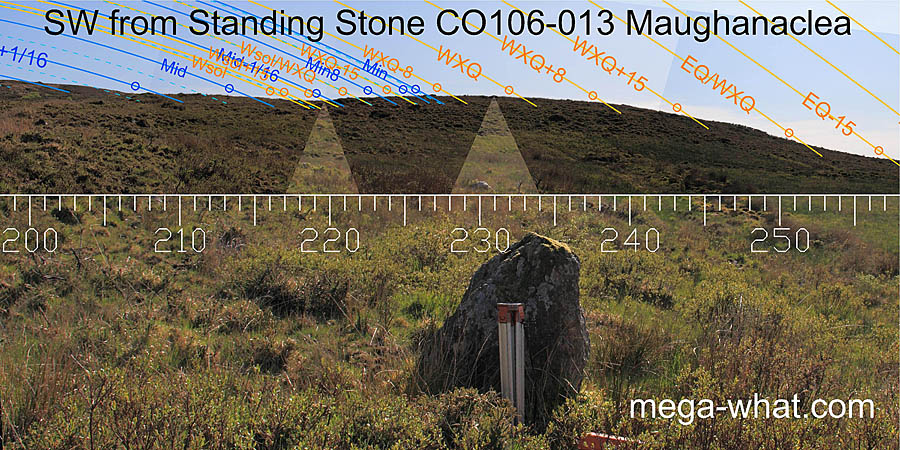 Maughanaclea Standing Stone
Maughanaclea Standing Stone:
The north-eastern axis is well beyond major standstill.
The south-west is harder to determine. A strict reverse axis c.210° would be lunar but
the shape could indicate the winter cross-quarters.
The line between the two standing stones could be said to indicate the summer cross-quarters.
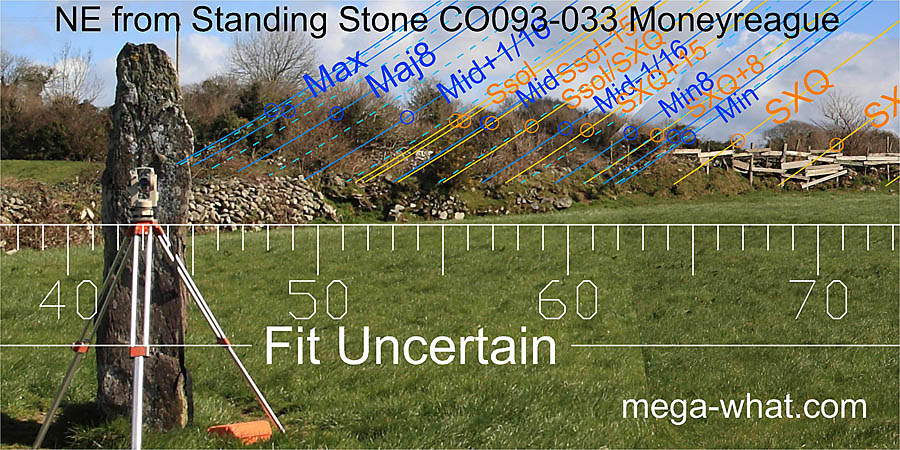
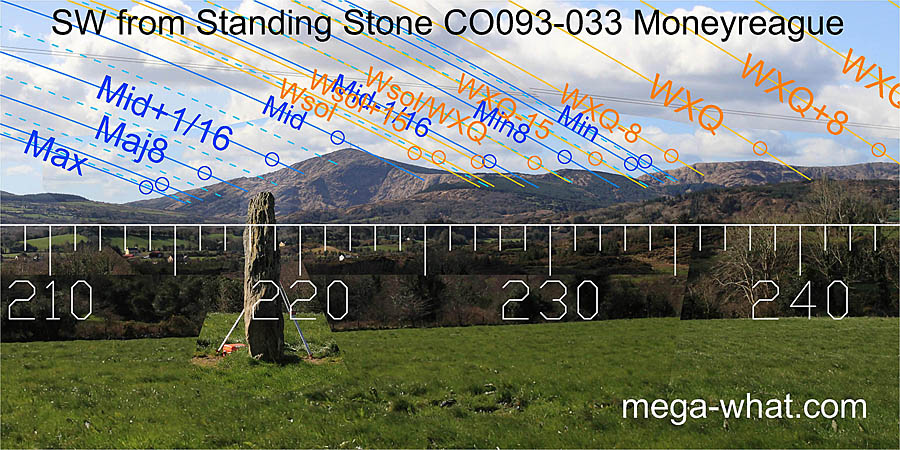 Moneyreague Standing Stone
Moneyreague Standing Stone:
The long axis is just beyond major standstill to the north-east but
points to the middle of the major half of the south-western lunistice range.

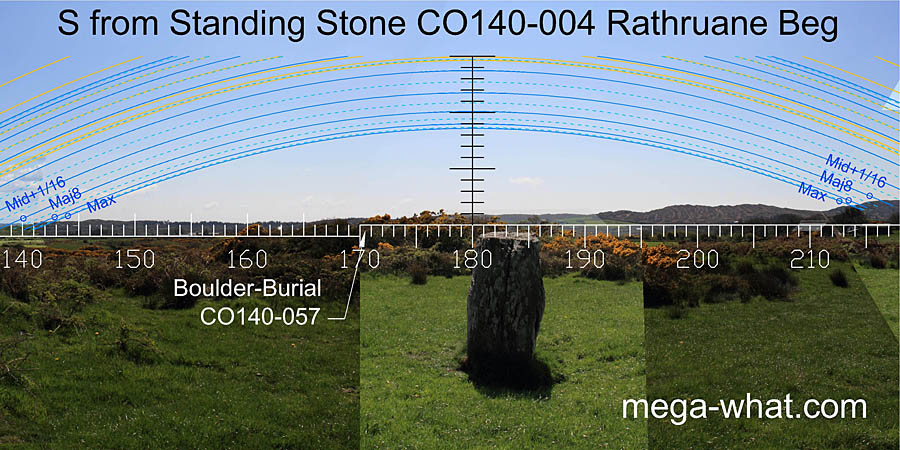 Rathruane Standing Stone
Rathruane Standing Stone:
The long axis is north-south and the offset visible here is because the theodolite was beside the stone.

 Reenmeen Standing Stone
Reenmeen Standing Stone:
When upright this stone would have indicated the equinox / winter cross-quarter midpoint to the south-west.
To the north-east, the same edge of the stone marks the summer cross-quarters. It is quite thick and spans about a week.

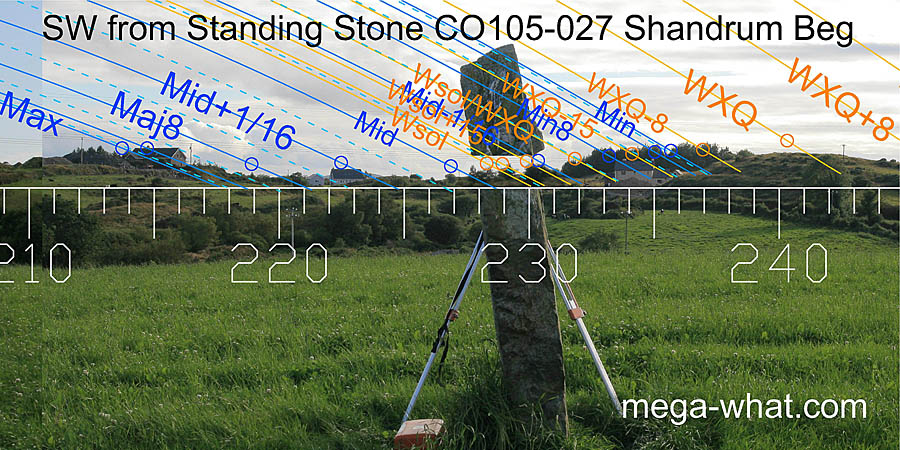 Shandrum Beg Standing Stone
Shandrum Beg Standing Stone:
Despite the lean it is clear that this stone was set so that the north-eastern long axis indicated major standstill.
To the south-west, it might have been intended for winter solstice sun sets.
This stone has since fallen and been re-erected at a different angle and quite possibly not in exactly the same place.
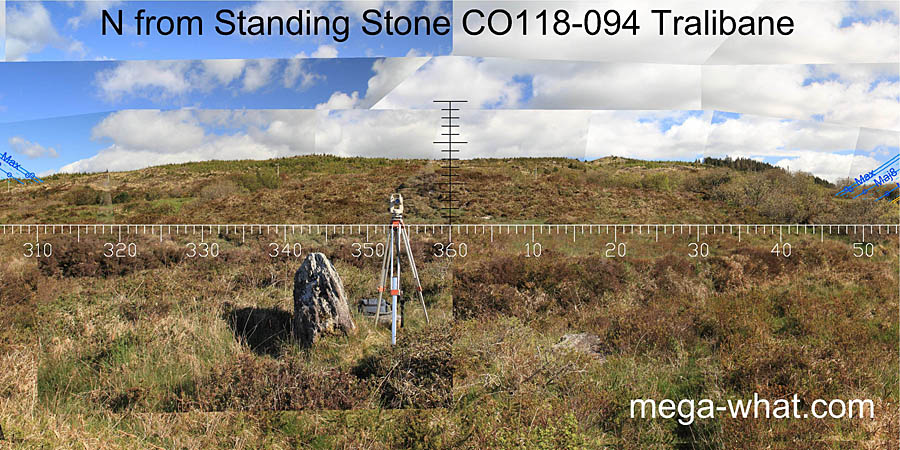
 Trawlebane Standing Stone CO118-094
Trawlebane Standing Stone CO118-094:
The long axis of this wide stone is anti-clockwise of north-south by perhaps as much as 20° and the offset visible here is because the theodolite was beside the east side of the stone.
© Michael Wilson.










